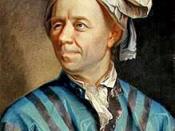Leonhard Euler, (born April 15, 1707, died Sept. 18, 1783), was the most prolific mathematician in history. His 866 books and articles represent about one third of the entire body of research on mathematics, theoretical physics, and engineering mechanics published between 1726 and 1800. In pure mathematics, he integrated Leibniz's differential calculus and Newton's method of fluxions into mathematical analysis; refined the notion of a function; made common many mathematical notations, including e, i, the pi symbol, and the sigma symbol; and laid the foundation for the theory of special functions, introducing the beta and gamma transcendal functions. He also worked on the origins of the calculus of variations, but withheld his work in deference to J. L. Lagrange. He was a pioneer in the field of topology and made number theory into a science, stating the prime number theorem and the law of biquadratic reciprocity. In physics he articulated Newtonian dynamics and laid the foundation of analytical mechanics, especially in his Theory of the Motions of Rigid Bodies (1765).
Like his teacher Johann Bernoulli, he elaborated continuum mechanics, but he also set forth the kinetic theory of gases with the molecular model. With Alexis Clairaut he studied lunar theory. He also did fundamental research on elasticity, acoustics, the wave theory of light, and the hydromechanics of ships.
Euler was born in Basel, Switzerland. His father, a pastor, wanted his son to follow in his footsteps and sent him to the University of Basel to prepare for the ministry, but geometry soon became his favorite subject. Through the intercession of Bernoulli, Euler obtained his father's consent to change his major to mathematics. After failing to obtain a physics position at Basel in 1726, he joined the St. Petersburg Academy of Science in 1727. When funds were withheld from...



Biography
I enjoyed reading your work!
You did a good job putting all the facts together. You forgot to mention that Euler produced almost half of his work during his last seventeen years of life - when he was blind.
His name is spelled like "oiler" by the way.
2 out of 2 people found this comment useful.